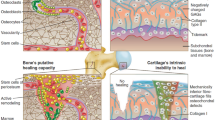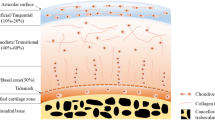
Overview
- Presents the latest developments and challenges as well as emerging technologies for the treatment of osteochondral lesions and defects
- Highlights in vitro mimetic models, and in vivo studies using small and big animal models for OCTE
- Presents the use of bioreactors and microfluidics for OCTE, including multi-chamber bioreactors
- Discusses properties of stem cells and cell-based therapies with applications for OCTE
Part of the book series: Advances in Experimental Medicine and Biology (AEMB, volume 1059)
Buy print copy
About this book
This book covers the most recent developments in the field of osteochondral tissue engineering (OCTE) and covers in detail the concepts and current challenges for bone and cartilage repair and regeneration. Specific topics include viscosupplementation, biologicals, tissue engineering approaches, in vitro and in vivo models, and technological advances with stem cells, bioreactors, and microfluidics. Osteochondral Tissue Engineering: Challenges, Current Strategies, and Technological Advances presents challenges and strategies in the field of osteochondral regeneration and serves as a core reference for biomedical engineering students and a wide range of established researchers and professionals working in orthopedics.
Similar content being viewed by others
Keywords
- stem cells OCTE
- stem Osteochondral tissue engineering
- in vivo models OCTE
- in vitro models OCTE
- drug-loaded models OCTE
- bioreactors Osteochondral tissue engineering
- microfluidics Osteochondral tissue engineering
- biologicals Osteochondral tissue engineering
- biomaterials Osteochondral tissue engineering
- viscosupplementation Osteochondral tissue engineering
- hyaluronic acid OCTE
- knee OC defects
- OC lesions ankle
- osteoarthritis Osteochondral tissue engineering
- IPN hydrogels OCTE
- cell-scaffold constructs OCTE
- anti-microbial OCTE
- Cartilage-bone interface models
Table of contents (20 chapters)
-
Front Matter
-
Current Challenges in Osteochondral Repair and Regeneration: Trauma vs Disease
-
Front Matter
-
-
Viscosupplementation
-
Front Matter
-
-
Technological Advances in Osteochondral Tissue Engineering
-
Front Matter
-
-
Osteochondral Tissue Engineering Approaches
-
Front Matter
-
Editors and Affiliations
About the editors
Dr. Joaquim Miguel Oliveira, BSc, PhD is a senior researcher “Investigador FCT 2012 and FCT 2015” at the Portuguese Government Associate Laboratory ICVS/3B´s-University of Minho. Currently, he is a volunteer lecturer at the Faculty of Medicine, U. Porto and Dept. of Polymer Eng., UM. Since 2001, he has been involved in the development of biomaterials from natural origin for tissue engineering and regenerative medicine. His research activities have been increasingly focused on nanomedicine, stem cells and 3D in vitro models of disease.
Dr. Sandra Pina, MsC, PhD, is an assistant researcherat the Portuguese Government Associate Laboratory ICVS/3B’s, University of Minho. Her research interests include bioresorbable calcium phosphate-based nanomaterials and ionic incorporated calcium phosphates nanocomposites for internal fracture fixation in traumatology, cranio-maxillofacial, spine and orthopaedic surgery.
Prof. Rui L. Reis, PhD, DSc, Hon. Causa MD (UGranada) is the Vice-Rector for R&D, Director of the 3B’s Research Group and of the ICVS/3B´s, of UMinho – Portugal. He is the CEO of the European Institute of Excellence on TERM, and the President-elect of Global TERMIS (Tissue Engineering & Regenerative Medicine International Society) and the editor-in-chief of the JTERM.
Prof. Julio San Roman, PhD, is director of Instituto de Ciencia y Tecnología de Polímeros CSIC. His scientific activities are centred in the study and development of polymer systems for biomedical applications, and specifically in tissue engineering, polymer drugs and drug delivery systems.
Bibliographic Information
Book Title: Osteochondral Tissue Engineering
Book Subtitle: Challenges, Current Strategies, and Technological Advances
Editors: J. Miguel Oliveira, Sandra Pina, Rui L. Reis, Julio San Roman
Series Title: Advances in Experimental Medicine and Biology
DOI: https://doi.org/10.1007/978-3-319-76735-2
Publisher: Springer Cham
eBook Packages: Biomedical and Life Sciences, Biomedical and Life Sciences (R0)
Copyright Information: Springer International Publishing AG, part of Springer Nature 2018
Hardcover ISBN: 978-3-319-76734-5Published: 24 May 2018
Softcover ISBN: 978-3-030-09569-7Published: 08 February 2019
eBook ISBN: 978-3-319-76735-2Published: 07 May 2018
Series ISSN: 0065-2598
Series E-ISSN: 2214-8019
Edition Number: 1
Number of Pages: IX, 511
Number of Illustrations: 7 b/w illustrations, 79 illustrations in colour
Topics: Regenerative Medicine/Tissue Engineering, Biomedical Engineering/Biotechnology, Biomaterials, Biomedical Engineering and Bioengineering



